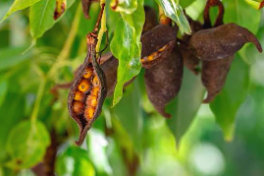
Identifying and Managing Phytophthora in Australian Bottle Trees
Published on April 9, 2025
Symptoms of Phytophthora in Australian Bottle Trees
Phytophthora infections in Australian bottle trees typically begin with root rot, which can be difficult to detect initially. As the disease progresses, above-ground symptoms become more apparent:
- Stunted growth compared to healthy trees of the same age
- Yellowing and wilting of leaves, often starting at the lower branches
- Premature leaf drop, creating thin canopy appearance
- Bark cracks and lesions, which may become infected with secondary pathogens
- Canker development on stems and branches as the infection spreads
- Discoloration and decay of wood in affected areas
It's important to note that these symptoms can be similar to those caused by other diseases or environmental stress factors. A proper diagnosis is essential before implementing treatment strategies.
Important: While yellowing foliage and leaf drop can be normal during seasonal changes, persistent symptoms or rapid decline should prompt immediate investigation.
Signs of Phytophthora Infection
Unlike symptoms (which are the tree's response to infection), signs are direct evidence of the pathogen itself:
- Oozing sap or black, tar-like substance from the bark, indicating the infection has progressed to the stem
- Fungal growth such as mushrooms or mycelium on or around the base of the tree
- Dark, water-soaked appearance of affected tissues when bark is removed
- Necrotic (dead) root tissue that appears brown or black instead of healthy white or tan
Prevention and Management
Preventing Phytophthora in Australian bottle trees requires a combination of cultural practices and, in some cases, chemical interventions:
Cultural Practices
- Plant in well-draining soil to prevent water accumulation around roots
- Avoid overwatering - Australian bottle trees are drought-tolerant once established
- Use proper mulching techniques - keep mulch away from the trunk to prevent moisture retention against bark
- Practice clean pruning with sanitized tools to prevent disease spread
- Remove diseased or dead wood promptly
- Avoid bark injuries that can create entry points for the fungus
- Improve soil aeration in heavy clay soils
Chemical Controls
Chemical treatments should be considered only after proper diagnosis and as part of an integrated management approach:
- Systemic fungicides containing phosphites or phosphonates can help manage Phytophthora
- Soil drenches with appropriate fungicides may suppress the pathogen
- Trunk injections might be recommended for valuable specimen trees
Caution: Chemical controls should only be used under the guidance of a certified arborist or horticulturist. Improper application can damage trees and ecosystems.
When to Consult a Professional
Consider consulting a certified arborist or plant pathologist if:
- Your tree shows multiple symptoms described above
- The disease appears to be spreading rapidly
- The tree is a valuable specimen or has historical significance
- You're unsure about proper diagnosis or treatment options
- Multiple trees in the area show similar symptoms
Conclusion
Phytophthora is a serious disease that can have devastating effects on Australian bottle trees in the Phoenix, AZ area. Early detection, proper cultural practices, and appropriate interventions are essential to protect these beautiful ornamental trees.
If you suspect your tree may be infected, don't wait until the disease has progressed too far. Contact a certified arborist or horticulturist for a proper diagnosis and a customized treatment plan that addresses the specific conditions of your landscape.
At Dendrology Consulting, our team of certified arborists specializes in diagnosing and treating Phytophthora and other tree diseases. Contact us for a professional assessment of your trees' health and personalized recommendations.
Need Professional Tree Care?
Our team of certified arborists can help diagnose and treat tree diseases, develop maintenance plans, and provide expert care for your valuable landscape assets.
Schedule a Consultation